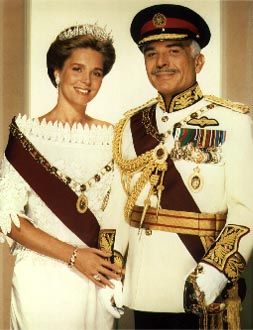Hussein of Jordan
|
|
Hussein bin Talal (Arabic: حسين بن طلال) (November 14, 1935 – February 7, 1999) was the King of the Hashemite Kingdom of Jordan from 1952 to 1999.
On July 20, 1951, King Abdullah I traveled to Jerusalem to perform his Friday prayers with his young grandson, Prince Hussein. He was assassinated by a gunman at the instigation of Colonel Abdullah Tell, ex-Military Governor of Jerusalem, and Dr Musa Abdullah Husseini, on the steps of one of the holiest shrines of Islam, the Al-Aqsa Mosque. Hussein grappled with the assailant, until he was wounded himself; he is said to have been saved from a bullet by a medal his grandfather had recently awarded him and insisted he wear.
Abdullah's eldest son, King Talal was crowned as King, but within a year was forced to resign because of mental illness (described as schizophrenia by Queen Noor in her book Leap of Faith). His son Prince Hussein was proclaimed King of the Hashemite Kingdom of Jordan on August 11, 1952 at age 16 and was enthroned on May 2, 1953.
His reign was controversial, while it saw Jordan remain one of the most free states in the Middle East, it was also marked by the events of Black September when the king ordered the violent expulsion of the PLO from Jordan. The country also defied the west and the other allied leaders by siding with Saddam Hussein in the Gulf War. In 1994 King Hussein led negotiations to end the official state of war with the State of Israel resulting in the Israel-Jordan Treaty of Peace. The king wrote three books: Uneasy Lies the Head (1962), about his childhood and early years as king, My War With Israel (1969), and Mon Métier de Roi.
King Hussein was an avid amateur radio operator. He also loved to fly airplanes (prop and jet) as well as helicopters.
He died of complications related to non-Hodgkin's lymphoma on February 7, 1999. The King had been suffering from the disease for many years and had visited the Mayo Clinic in Rochester, Minnesota, United States on a fairly regular basis for treatment. Just before his death, he changed his will and disinherited his brother, Hassan, who had been crown prince for several decades, and designated his eldest son, Abdullah as heir. The King was at the time of his death one of the longest serving leaders in international politics.
He was married four times. His four wives were:
- Sharifa Dina bint 'Abdu'l-Hamid, an Egyptian-born third cousin of King Hussein's father, King Talal, on April 19, 1955. A graduate of Cambridge University and a former lecturer in English literature at Cairo University, the bride was 26 to the groom's 19. They separated in 1956 and were divorced in 1957, at which time Queen Dina became known as Princess Dina. She became an Egyptian citizen in 1963, and in October 1970, Princess Dina of Jordan married Asad Sulayman Abd al-Qadir, alias Salah Taamari, a Palestinian guerilla commando who became a high-ranking official in the Palestine Liberation Organization.
- Daughter: Alia (born 1956).
- Antoinette Avril Gardiner (born Chelmondiston, England, 1941, renamed Muna al-Hussein on conversion to Islam), on May 25, 1961. An award-winning field hockey player, former typist, and daughter of a British army officer turned innkeeper, Lt. Col. Walter Percy Gardiner, she was given the title Princess Muna al Hussein on January 30, 1962, divorced 1972.
- Children: Abdullah (born 1962), Faisal (born 1963), Aisha (born 1968), Zein (born 1968)
- Alia Baha ed Toukan (1948-1977), after whom Jordan's international airport (Queen Alia International Airport) is named.
- Elizabeth (Lisa) Najeeb Halaby (renamed Queen Noor al Hussein on her conversion to Islam),
King Hussein was succeeded as king by his eldest son Abdullah II of Jordan.
External links
- A Living Tribute to the Legacy of King Hussein I (http://www.kinghussein.gov.jo/) - official Royal Jordanian memorial website

